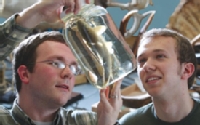BIOL 125/126: Molecules, Cells and Organisms/ Genes, Diversity and Ecology
Name: Sean Boaglio
Hometown: Longview, Wash.
Major: Undeclared, leaning Biology
Professor: Jacob Egge, assistant professor of biology

Sean’s advice to first-year students: “Study with someone. It is a great way to meet people in your class. And when you explain something to someone else, it also helps you understand it better.”
For students who want to enter PLU’s rigorous Health Sciences track, the first classes they will take are Biology 125 and 126. The two-semester set, called the biology introductory core sequence, seeks to lay the educational foundation for the many students who hope to enter fields of biological study including the medical profession.
Sean Boaglio ’13 is one of those students. He says he’s seen a lot of students – the best at their high schools – have difficulty adjusting to the intensity of the coursework. It is just so different from high school. “You really have to connect concepts in this class,” he said. “You just can’t memorize information and then forget it. You have to apply it.
“And you have to take advantage of your professor as a resource,” added Boaglio. “I never hesitated to e-mail my prof when I had a question, and I always got a response. ”
If you talk to Assistant Professor of Biology Jacob Egge, one of two professors that teaches Biology 126, it is clear that he and other faculty members have worked hard to develop a course structure that supports students.
“We are making a deliberate effort to give the introductory biology courses a more welcoming, personal experience that students expect from a place like PLU,” said Egge.
For instance, the two profs break down Bio 126 to smaller groups. Students have the same professor for their lab that they do for lecture. This way, even though multiple profs teach the courses, a given student will only interact with one professor. Egge estimates he sees his students four times a week for a total of about six hours between lecture and lab.
“This level of interaction in an introductory course gives me time to get to know my students and assess them as individuals much more effectively,” Egge said. “Every student has an opportunity to be successful in the course, but the outcome is ultimately determined by the individual student.”
Boaglio has seen a lot of really good students not put in the effort, and it has hurt them. “I know some kids who thought they could coast, because that’s what they did in high school,” he said. “But coasting is a different pace here. You can’t coast uphill.”
To read about BUSA 201, click here.


